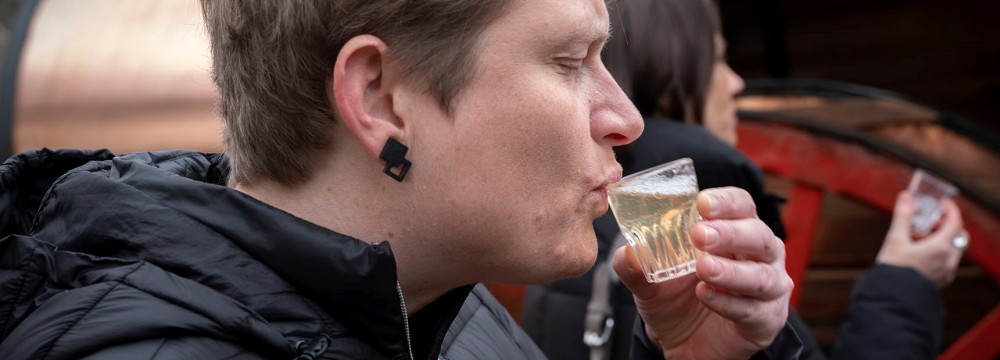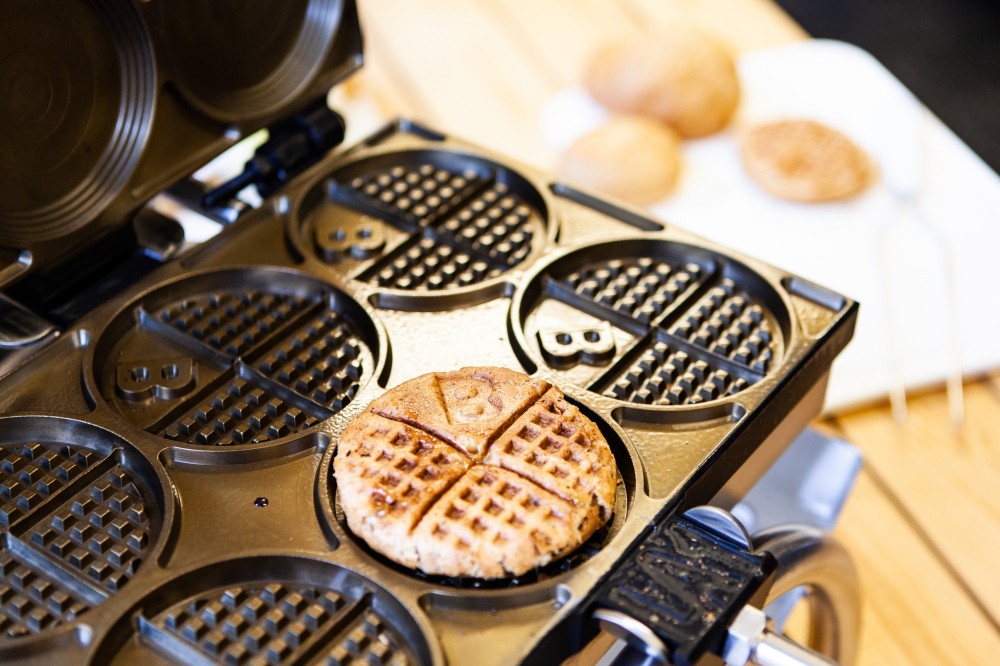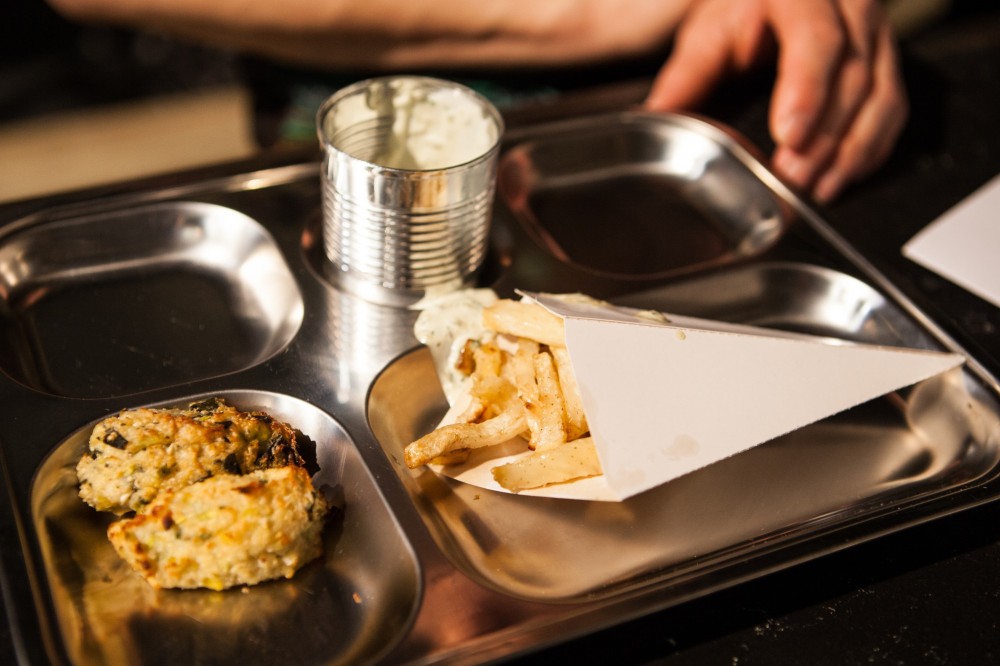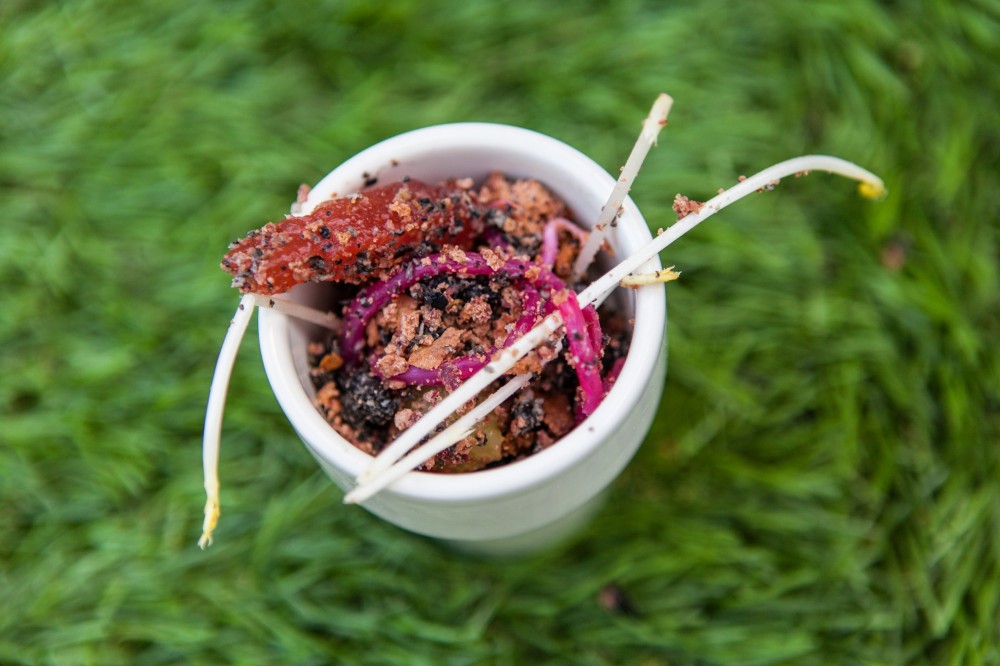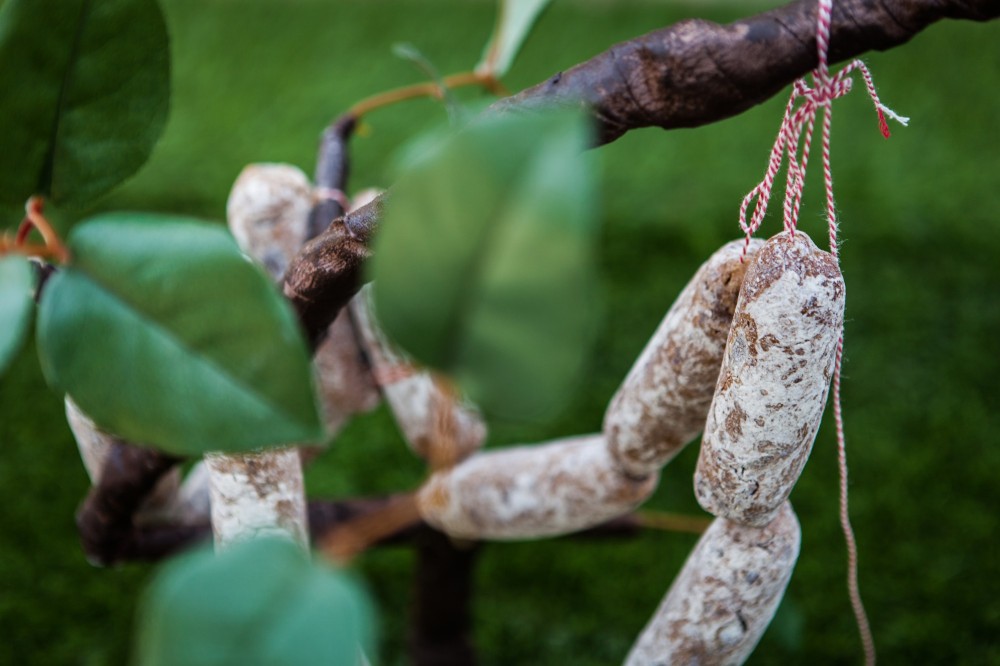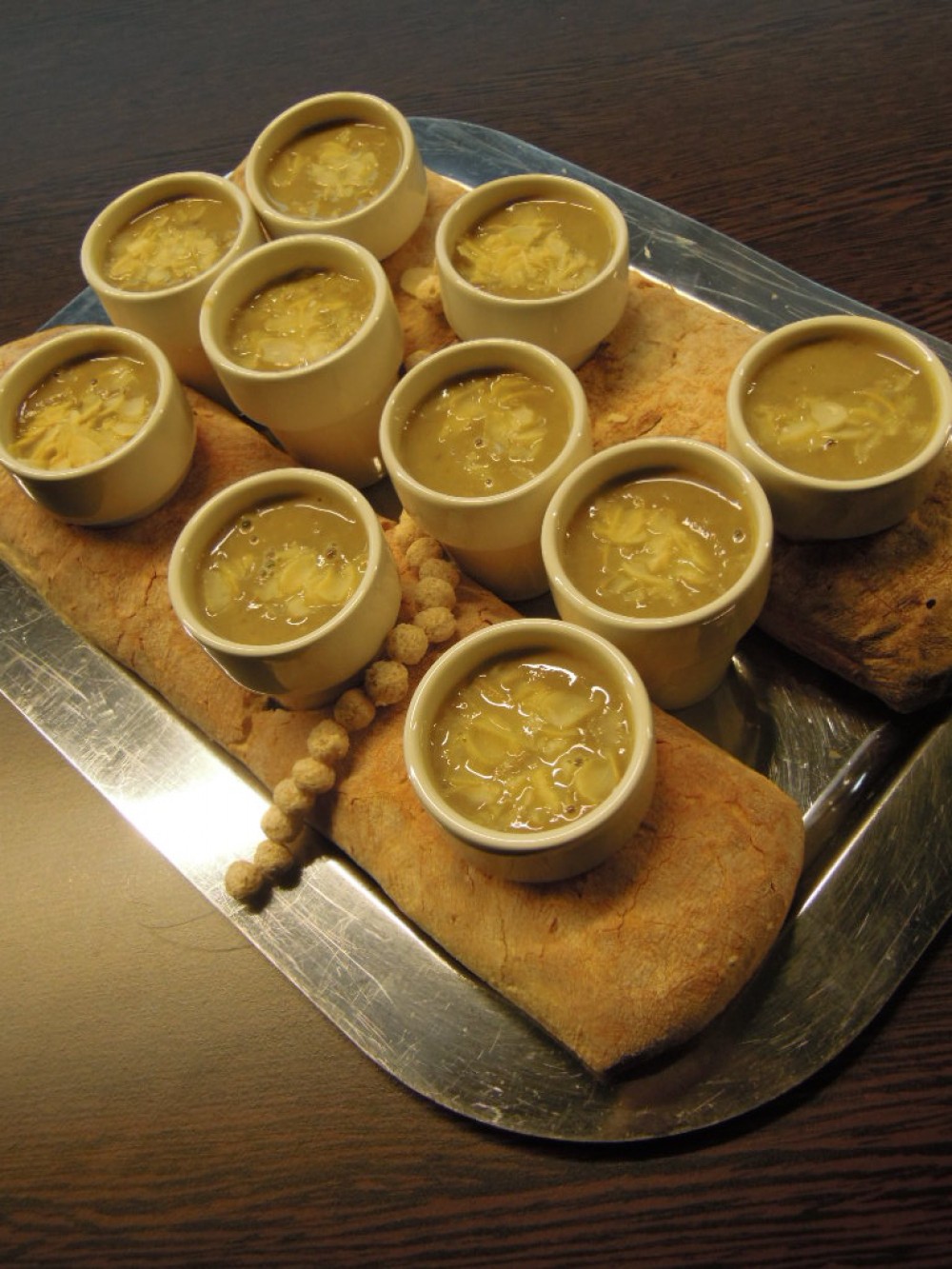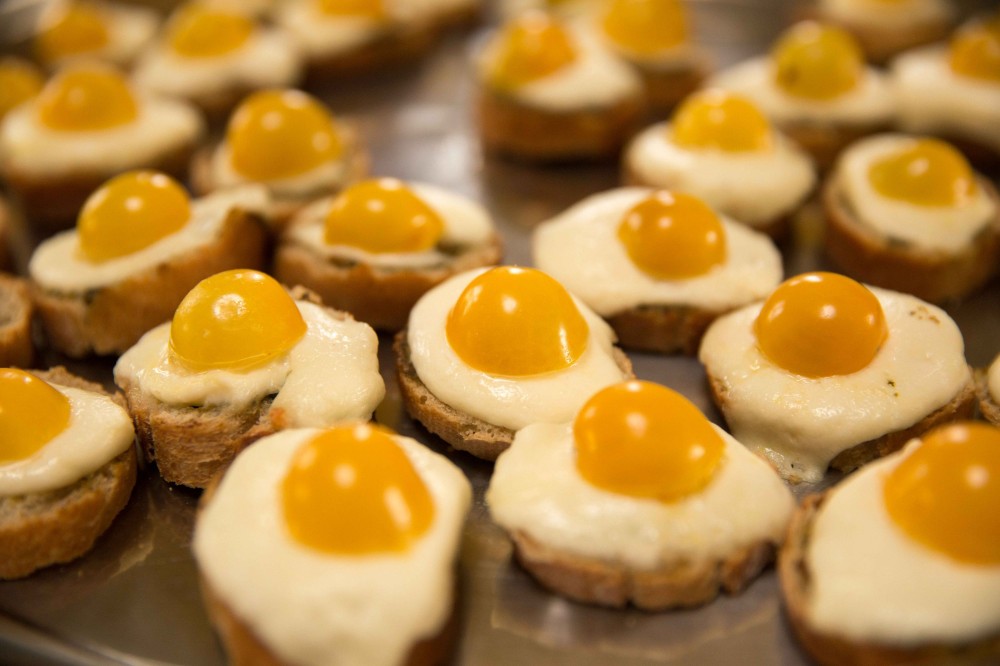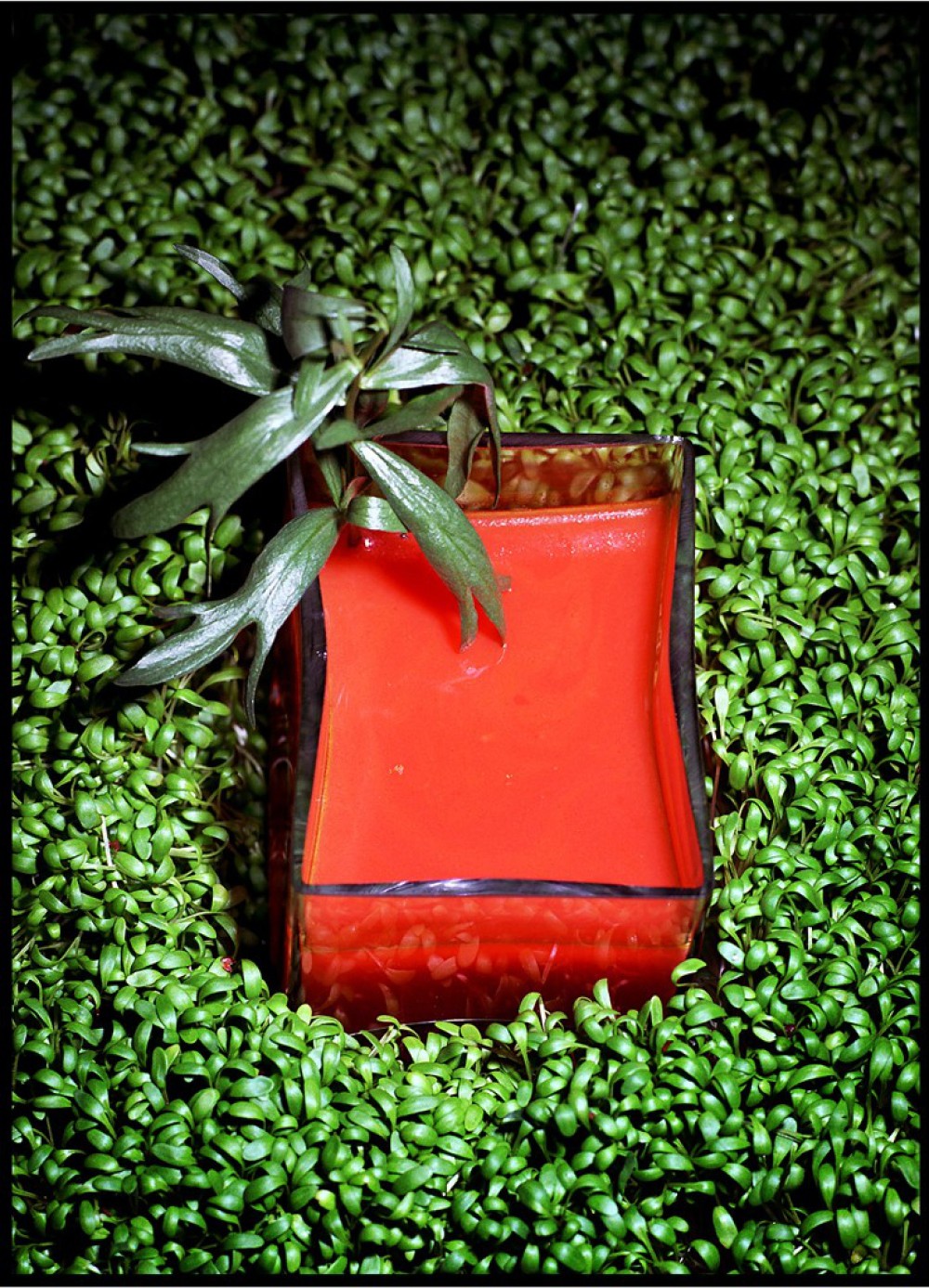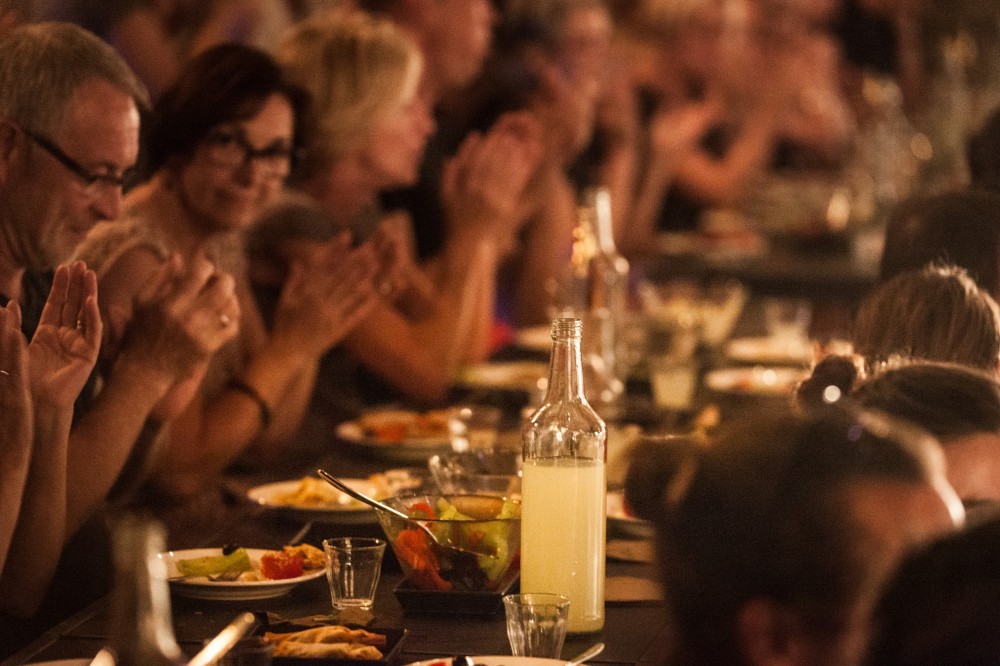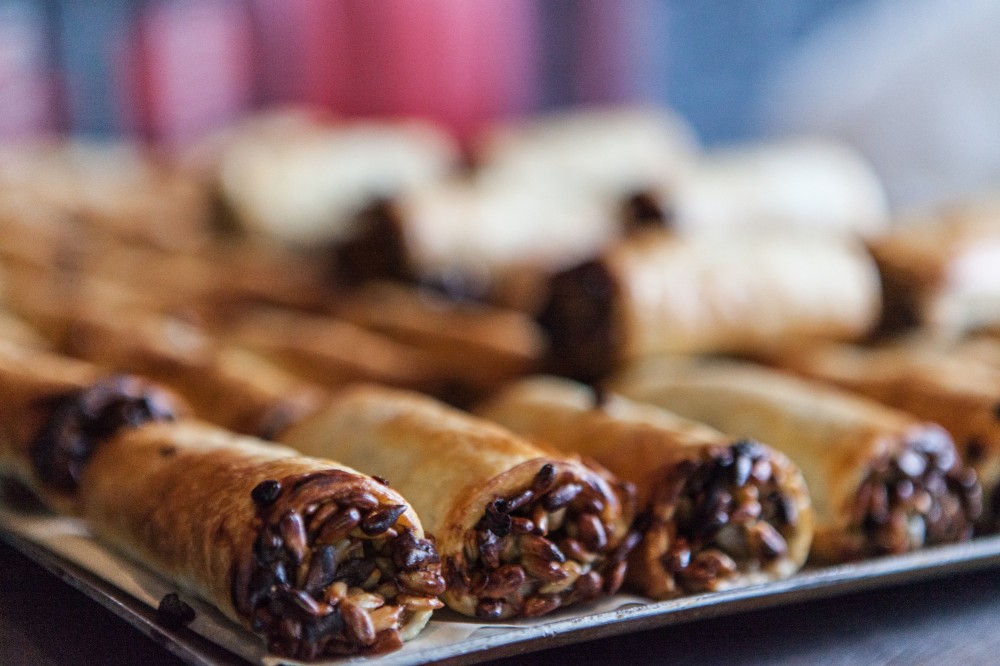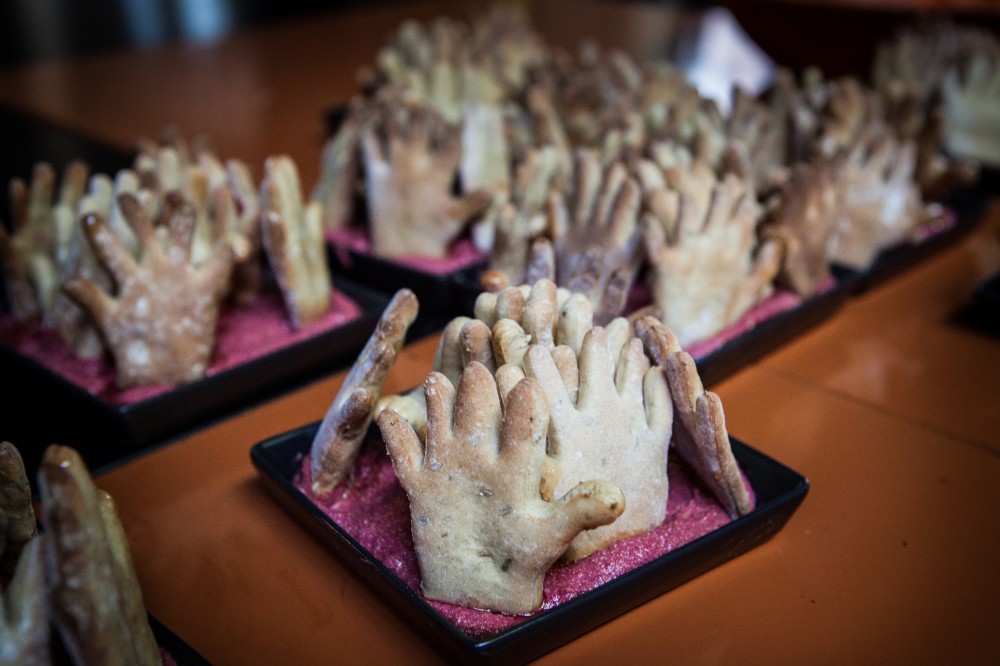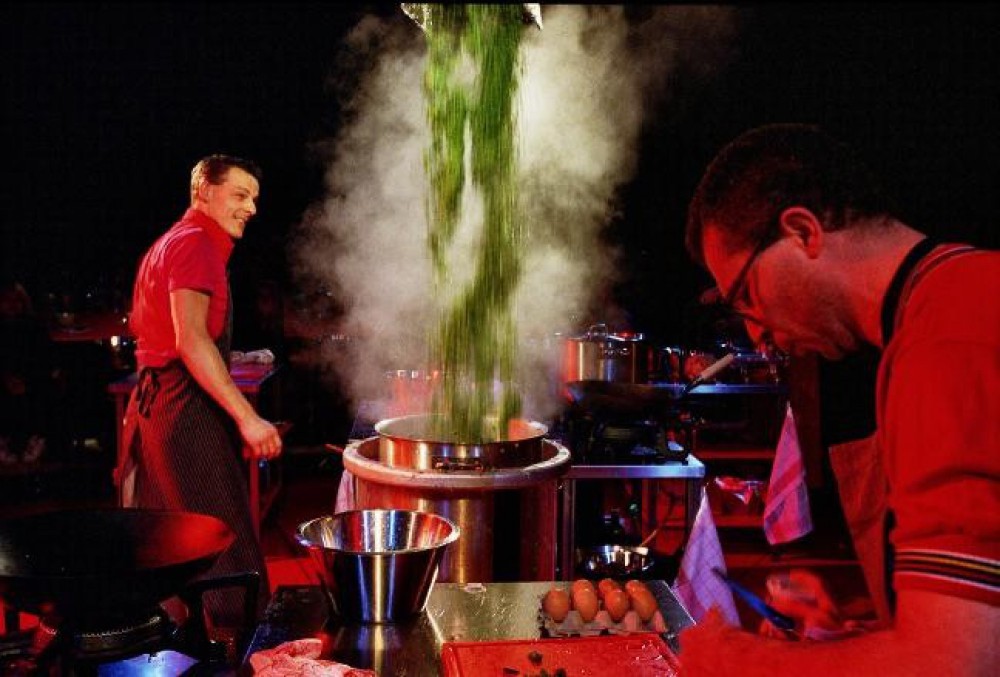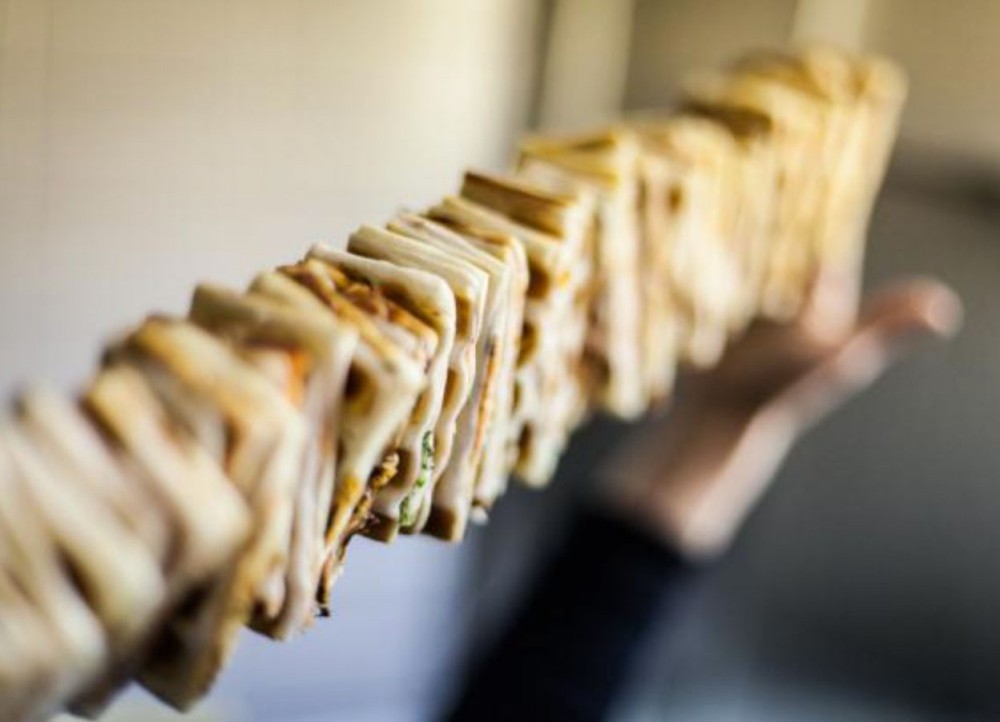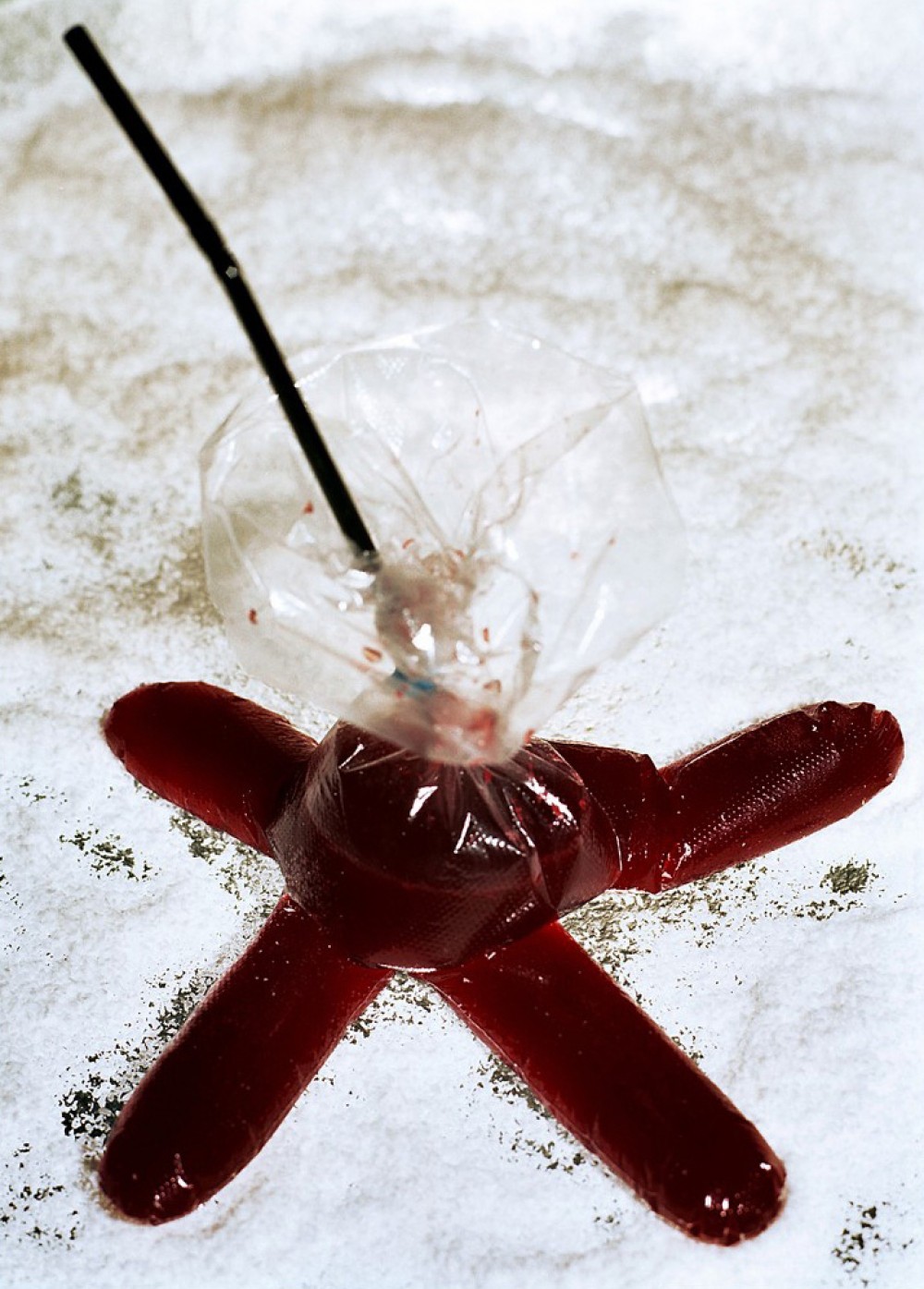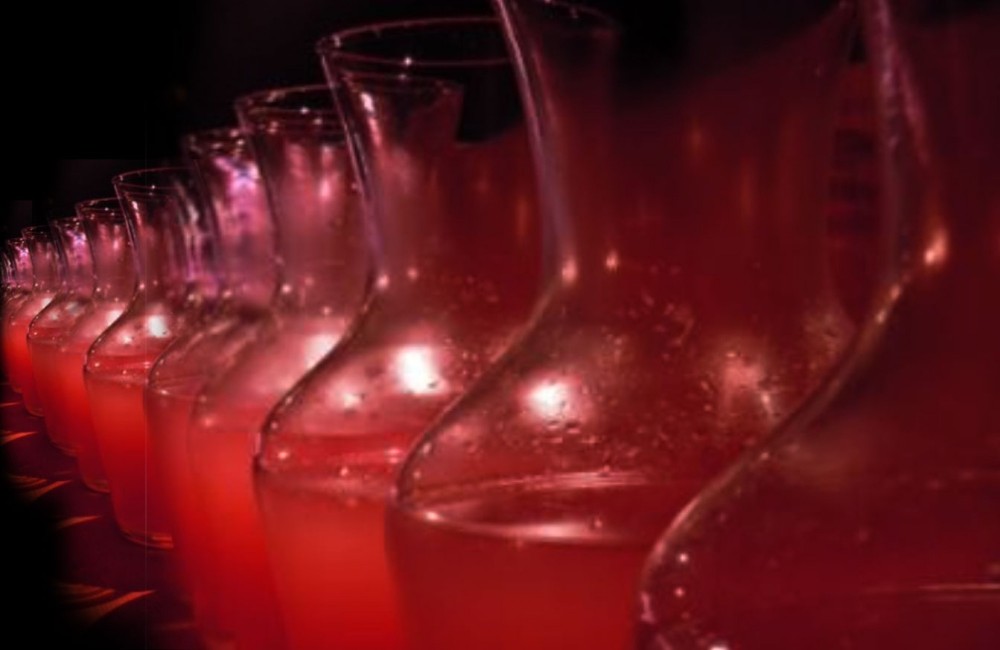A recipe from Potato Soup, a contemporary show about war and loss, about hunger and about the virtues of ... delicious soup.
Ingredients for 8 to 10 small bowls (2 litres )
25 g butter or a splash of oil
200 g onion, chopped
300 g carrots, diced
½ leek, washed and sliced thinly
300 g celeriac, peeled and diced
1 parsnip, peeled and diced
1 courgette, washed and diced
4 vegetable stock cubes
4 sprigs of fresh tarragon or 1 teaspoon of dried tarragon
1 teaspoon of dried thyme
2 sprigs of fresh thyme
1 teaspoon of dried parsley
pinch of salt
Preparation
Place the pot on the stove and switch it on.
When the pot is hot, add the butter or oil.
Sauté the onion and carrots in the butter for a few minutes until glazed.
Add the fresh thyme leaves.
Now add the other vegetables: celeriac, leek, parsnip, courgette.
Add enough water to cover the vegetables.
Crumble the 4 stock cubes into the soup.
Season with (dried) tarragon, thyme, parsley and salt.
Cook for 20 minutes or so.
If using fresh tarragon: add at the last minute.
Blend until you obtain a smooth liquid.
Add more water if the soup is too thick.
Tuck in and enjoy!
Lightly sparkling, fresh and crisp non-alcoholic beer made of hop syrup and the organic cereal drink Nagra. This recipe takes its inspiration from 16th-century home cooking. It has been developed by Peter De Bie and the 'Food Archaeologist' for The World of Bruegel. It has been a perfect thirst quencher for all ages since the 16th century!
Ingredients for 24 helpings, 5 cl per person
50 g sugar
50 g water
2 g Hallertau Blanche hop pellets
1 l Nagra (www.nagra.be)
Hop Syrup
Bring 50g water to the boil with 50g sugar and add the hop pellets. Transfer into a glass jar when still piping hot. Seal well and keep in a cool environment.
Small Beer
Dilute the hop syrup with 12cl of water then mix into 1 l Nagra.
Serve cold in 5-cl glasses.
This dish takes its inspiration from16th-century home cooking in Bruegel’s day. It has been developed by Peter De Bie at the request of Visit Flanders, within the framework of Aan tafel met Vlaamse Meesters (At the Table with Flemish Masters), and can be sampled at Laika’s Pushkitchen at Bokrijk Open-Air Museum during the Exhibition De Wereld van Bruegel (Bruegel’s World).
makes 12 pieces
mastellen
300 g maslin (= a mix of 250 g wheat flour and 50 g rye flour)
20 g camelina
42 g fresh yeast
1 egg
20 g panela
30 g butter
130 g milk
4 g salt
3 g cinnamon
2 g grains of paradise
a pinch of mace (or nutmeg) and one of ginger powder
1 egg, beaten
2 apples, peeled and cored, in 1/2cm slices
butter
dark brown sugar
parsnip cream
300 g parsnips, peeled and diced
25 cl rice milk (or plain milk)
rapeseed oil
finishing
peeled rapeseed
baking paper and an iron or waffle iron/grill
mastellen
Crumble the yeast. Add the egg and mix until it forms a homogenous paste. Stir the 3 types of flour, sugar, salt and the softened butter plus spices into the milk.
Lightly sprinkle your work surface with flour and knead the paste into an elastic dough.
Leave to rise 45’.
Divide the dough into 12 equal parts and make balls each weighing roughly 50 g.
Cover the baking tray with baking paper, dot the dough balls across it and leave 30’.
Preheat the oven to 225° C.
Use a thumb to press a small well into each ball. Take a piece of dough into both hands and place both thumbs inside the small well. Now give the mastel a whirl with your other fingers. Repeat with each mastel, and place back on the baking tray. Leave another half hour.
Brush each piece with beaten egg (make sure to include the well).
Leave to rise another half hour.
Bake for 7 to 8 minutes.
Meanwhile pepare the parsnip cream
parsnip cream
Boil the diced parsnips in the rice milk. Remove and blend. Add the cooking liquid, a splash of oil and mix into a smooth puree. Season with salt. Leave to cool.
Slice the mastel in two, butter both halves and sprinkle the bottom half with dark brown sugar. Top with an apple slice, followed by the other mastel half. Wrap the whole in baking paper and flatten with a hot iron in order to caramelize the sugar and cook the apple. A waffle iron or grill will also do the trick (no need for baking paper in that case)
finishing
Cover the mastel with the parsnip cream as if it were whipped cream and sprinkle with rapeseed.
A recipe from CANTINA.
for 12 people
Ingredients
Cauliflower fish
2 tbsp olive oil
1 onion
1 leek
3 cloves of garlic
600 gr of cauliflower
250 gr of courgette
2 eggs
120 gr almond flour
150 gr ricotta cheese
1 lemon (grated zest only)
1/2 tsp sea salt
Chips de céleri-rave à la sauce tartare
1 grand céleri-rave, pelé
1 dl d’huile végétale, sel de céleri
pour la sauce :
1 dl de mayonnaise
1 cuillère à café de moutarde de Dijon
1 cuillère à soupe de petits cornichons finement hachés
1 cuillère à soupe de câpres
1 cuillère à soupe de coriandre finement hachée
50 gr de yoghourt
Preparation
Cauliflower fish
Preheat the oven to 200°. Slice the onion and garlic. Chop the leek into thin strips. Fry in olive oil until the onion, garlic and leek are soft. Meanwhile, chop the cauliflower florets and stems in the kitchen robot. Grate the zucchini into fine strings. Break the eggs and beat them. Add the leek, garlic and onion mixture, cauliflower and zucchini and other ingredients. Make nice dumplings the size of a spoon and place them on baking paper on a baking tray. Bake in the oven for 25 to 30 minutes at 200° until they are golden brown.
Chips de céleri-rave à la sauce tartare
Preheat the oven to 200°. Cut the celery root into thick, old-fashioned chips. Put a heavy roasting pan in the oven for 10 minutes and pour in the oil. Put the roasting pan back in the oven and let the oil become hot for a minute or two. Carefully place the celery chips in the hot oil and bake for 30 minutes until crisp. Turn them around halfway through the baking time. Meanwhile, mix everything for the tartar sauce. Let the fries drain on kitchen paper. Sprinkle with celery salt and serve the tartar sauce as a dip.
(from: The Green Kitchen at Home by David Frenkiel & Luise Vindahl)
A recipe from Piknik Horrifik
Cucumber slug, water melon worm and bean spouts
Ingredients
2 cucumbers
7 cl ponzu sauce
¼ water melon
5 cl teriyaki
200 gr bean sprouts
3 cl red beetroot juice
10 gr miso yuzu paste
3 cl sesame oil
You will also need
a plastic tube 2 cm in diameter
Red bean clay
Ingredients
300 gr red beans (drained)
2 gr cumin seeds
pinch cayenne pepper
25 gr sprigs of coriander
1 lime
coarse salt
Black olive earth
Ingredients
65 gr panko or breadcrumbs
100 gr black pitted olives
8 gr squid ink
coarse salt
15 pea shoots
These recipes are intended for 10 people because we believe that enjoying a good meal together promotes mutual understanding and 'savoir vivre'. We also believe that ‘together’ should be interpreted as ‘the more, the merrier’.
Cucumber slug, water melon worm and bean spouts
Preparation
Halve the cucumber and remove the seeds using the plastic tube. Divide the seeds into three parts of approx. 5 cm and marinate them with 5 cl ponzu.
Peel the watermelon and cut it into long strips the width of your little finger. Marinate the strips in teriyaki sauce.
Fry the bean sprouts briefly in sesame oil. Marinate them with a mixture of red beetroot juice, 2 cl ponzu and miso yuzu paste.
Place the various worms in a plastic bag, extract the air from the bag and seal. Leave in the refrigerator overnight to draw. Then roll up the seeds of the cucumber slug and they will look like snails.
Red bean clay
Preparation
Heat the oven to 120° C. Roast the cumin seeds and squeeze the lime. Mix all the ingredients together in the blender. Scatter a thin layer of the mixture on baking paper and bake for 20 minutes until it is semi-dry and looks like clay.
Black olive earth
Preparation
Mix the panko or breadcrumbs, the olives, the ink and the salt in the blender. Allow the mixture to dry briefly in the oven at 120° C.
Arrange the worms of cucumber, the melon and soya on top of a layer of clay and earth. Finish with a top layer of earth and a few pea shoots so that the worms are still visible. Serve on a garden trowel.
A recipe from Piknik Horrifik
Ingredients
250 gr rye flour
275 gr self-raising flour
100 gr raisins, soaked
40 gr pitted dates
40 gr dried figs
25 gr dried mulberries
4 gr yeast
10 gr coarse salt
0.3 l liquid from the soaked raisins
a little flour
You will also need
a large needle and thread
This recipe is intended for 10 people because we believe that enjoying a good meal together promotes mutual understanding and 'savoir vivre'. We also believe that ‘together’ should be interpreted as ‘the more, the merrier’.
Preparation
Soak the raisins overnight in half a litre of water. Retain 0.3 l of that water. Chop the dates and figs finely. Mix the rest of the ingredients plus the water retained after soaking the raisins, knead to a uniform dough and set aside for 2 1/2 hours to rise. Then divide into 95-gr. portions and roll each portion into a sausage shape. Wrap carefully in cling film. Heat the oven to 180 C and bake the sausages for 10 minutes. Remove the cling film, roll the sausages immediately in a little flour and bake for a further 6 minutes in the oven. Join them together with the needle and thread to form a chain of 10 pieces.
A recipe from Opera Buffa
Ingredients
400 g chestnuts (ready peeled, usually vacuum packed)
oil
1 leek (washed and cut up)
6 cl dry sherry
100 g mushrooms
600 ml stock
salt and pepper
200 ml milk
almond flakes
Preparation
Heat the oil over a moderate heat. Add the leek and sauté until soft. Pour in the sherry and allow the mixture to reduce to approximately a quarter on a moderate heat for 3 to 4 minutes. Add the chestnuts, mushrooms and stock and bring to the boil until everything is cooked.
Pureé or mix the mixture. Add milk and then salt and pepper to taste. Garnish the soup with the roasted almond flakes (and roasted chestnut dolls).
A recipe from Aromagic
Ingredients
500 gr mozzarella
a baguette
8 yellow cherry tomatoes
freshly ground pepper
pesto
Preparation
Cut the baguette into slices 1 cm thick, spread them with pesto and toast in the oven. Allow to cool. In the meantime cut the mozzarella into disks and the tomatoes in half. On each piece of toast lay a mozzarella disk and on top of that in the middle half a tomato. Bake briefly in the oven until the mozzarella begins to melts. Grind over a little pepper just before serving.
• 104,133 people have eaten at Laika performances in the last 15 years.
• We served 59,911 portions of soup, or over 10,000 litres.
• We used 856 kg ginger and 6,848 root vegetables.
• We melted 570 kg chocolate, i.e. the weight of 38,000 bars of chocolate.
• We squeezed 22,152 lemons.
A recipe from Pentamerone. A ginger-based infusion because ginger is Peter’s favourite ingredient and it stimulates the senses. The addition of a small quantity of gin brings out the taste of the ginger. The drink is combined with cucumber skin and seed so that nothing is wasted. A truly ecological consideration.
Ingredients for 10 people
250 gr ginger
6 lemons, 3 of them peeled
150 gr sugar
3 L soda water
2 cucumbers
30 cl gin
Wash the ginger well, cut into thin slices and crush in blender. Cut the cucumber (with skin and seed) into little cubes. Mix everything with the peel of 3 lemons and juice of 6 lemons, sugar, cucumbers and soda water. Leave overnight. Strain and mix with gin. Serve cold.
A recipe from Pentamerone. The ‘mergpijp’ – at least the vegetarian pastry version – is reminiscent of the bones the monstrous flea likes to pick; the sunflower seeds are incorporated because of the summery atmosphere most of the stories in ‘De Pantamerone’ exude. The combination with the shiitakes alludes to the dark, squelchy forest that is home to the flea and where Cienzo and Menucella meet. There is a hint of myrtle in the rosemary garniture.
Ingredients for 10 people
150 gr sunflower seeds
15 cl milk
3 cl Tamari or soya sauce
100 gr shiitake mushrooms
300 gr puff pastry
10 small sprigs of fresh rosemary
Boil the sunflower seeds in the milk and mix the Tamari through it. Allow to cool and leave overnight in the refrigerator.
Cut the shiitakes into small pieces and fry them in the pan. Mix in the sunflower seeds.
Roll them up in pastry squares measuring 10 by 10 cm. Bake in preheated oven at 190 °C and cut them in two. Serve upright, garnished with a sprig of rosemary.
A recipe from Aromagic
Ingredients
250 gr curd cheese
200 gr cream cheese (Philadelphia type)
juice of 1/2 lemon
juice of 1/2 orange
120 gr sugar
25 cl cream
10 gr gelatine leaves
2 sachets vanilla sugar
raspberry coulis
handful of mint
Mix together curd cheese, cream cheese, vanilla sugar, lemon juice and orange juice. First allow gelatine leaves to soak in cold water and then dissolve in warm sugared water. Then mix this into the cheese mixture. Next carefully fold in the beaten cream and add a little raspberry coulis for colour. Allow to stiffen in the refrigerator.
Can be served in any shape, but it looks very realistic in a mould in the shape of the two halves of a brain! Present with raspberry coulis and a couple of leaves of fresh mint.
A recipe from Patatboem
Ingredients
1,3 kg peas
4 potatoes
1 bunch of mint about 50 gr, picked
20 gr wasabi
80 gr sour cream
1 egg
nutmeg
Preparation
Peel the potatoes and cook them. Boil the peas. Mix the sour cream, the egg, the mint and the nutmeg. Purée the peas, the potatoes and the dressing. Work it off with a touch of wasabi.
A recipe from Cucinema
Ingredients
1 roll of puff pastry
100 gr smoked salmon
fresh dill
For the cream
150 gr sour cream
horseradish purée to taste
Materials
waffle iron
Preparation
Roll out the puff pastry and cover half of it with slices of smoked salmon and dill. Fold up and cut out the size of waffle you require (e.g. 7 x 5 cm). Cook in the waffle iron until golden brown. Mix the sour cream with the horseradish and serve this with the waffles while they are still warm.
A recipe from PEEP&EAT
Ingredients for 8 people
20 cl homemade elderflower syrup
50 cl gin
35 cl lime syrup
35 cl lemon juice
80 cl to 1 l soda water
Materials
10 plastic disposable gloves (available from medical suppliers and paint shops)
10 black straws
10 pieces blue plastified wire
Preparation elderflower syrup
20 cl elderberry juice (picked and pressed yourself or from a natural food store)
4 cl gin
6 cl jenever
60 gr white sugar
20 gr dark candi sugar
Preparation
First make the elderflower syrup. It will keep for a long time and so can be made in large quantities. Mix the elderberry juice with the gin, the jenever, the white sugar and the candi sugar. Stir everything together thoroughly until the sugars have dissolved.
Then mix the elderflower syrup with the gin, the lime syrup and the lemon juice and carbonated water according to taste. Take a glove and fill the four fingers with approximately 18 cl of the cocktail. Place the straw in the glove, wind the thumb round the straw and fix in place with a piece of plastified wire. Arrange the gloves on a tray and place in the refrigerator. Serve cold.
A recipe from Opera Buffa
Ingredients
160 gr fresh ginger
4 lemons
couple of sprigs of fresh mint
60 gr sugar
1 l soda water
20 cl cranberry juice
20 cl vodka (or quantity according to taste)
Preparation
Peel the ginger and chop finely. Chop the mint finely. Peel 2 lemons and set the peel aside. Then squeeze the peeled and unpeeled lemons. Leave the ginger, the lemon peel, the lemon juice, the sugar and the carbonated water in the refrigerator to infuse overnight. Strain everything and mix with the vodka and the cranberry juice. Serve chilled.


















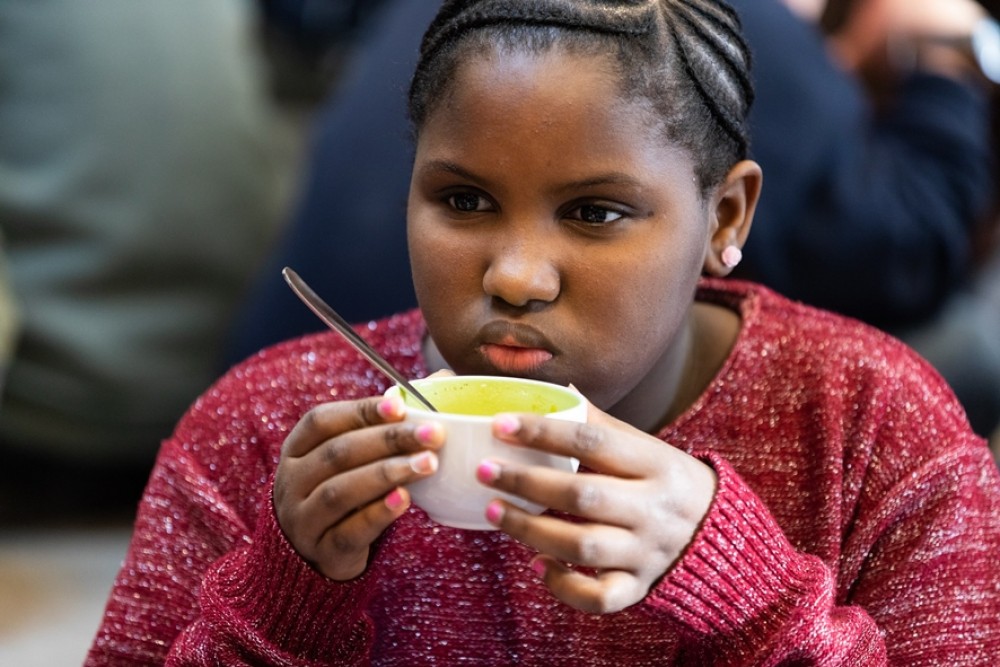
 read more
read more